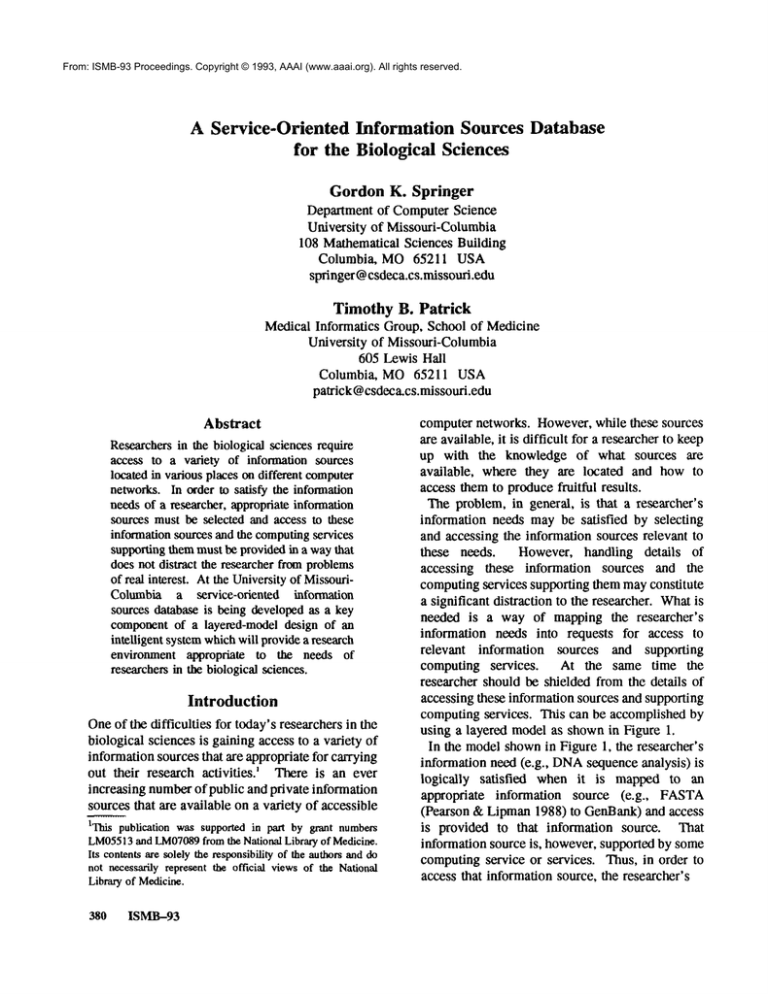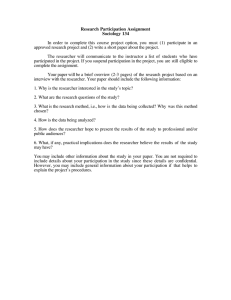
From: ISMB-93 Proceedings. Copyright © 1993, AAAI (www.aaai.org). All rights reserved.
A Service-Oriented Information Sources Database
for the Biological Sciences
GordonK. Springer
Department of Computer Science
University of Missouri-Columbia
108 Mathematical Sciences Building
Columbia, MO65211 USA
springer@csdeca.cs.missouri.edu
TimothyB. Patrick
Medical Informatics Group, School of Medicine
University of Missouri-Columbia
605 Lewis Hall
Columbia, MO65211 USA
patrick@csdeca.cs.missouri.edu
Abstract
Researchersin the biological sciences require
access to a variety of information sources
locatedin variousplaces on different computer
networks.In order to satisfy the information
needsof a researcher, appropriateinformation
sources must be selected and access to these
informationsourcesand the computingservices
supportingthemmustbe providedin a waythat
does not distract the researcher fromproblems
of real interest. At the Universityof MissouriColumbia a service-oriented information
sources database is being developedas a key
componentof a layered-model design of an
intelligent systemwhichwill providea research
environment appropriate to the needs of
researchersin the biologicalsciences.
Introduction
Oneof the difficulties for today’s researchers in the
biological sciences is gaining access to a variety of
informationsources that are appropriate for carrying
out their research activities.’
There is an ever
increasing numberof public and private information
sources that are available on a variety of accessible
tThis publication was supported in part by grant numbers
LM05513
and LM07089from the National Library of Medicine.
Its contents are solely the responsibility of the authors and do
not necessarily represent the official views of the National
Library of Medicine.
380 ISMB--93
computer networks. However,while these sources
are available, it is difficult for a researcherto keep
up with the knowledge of what sources are
available, where they are located and how to
access themto producefruitful results.
The problem, in general, is that a researcher’s
information needs maybe satisfied by selecting
and accessing the information sources relevant to
these needs. However, handling details of
accessing these information sources and the
computingservices supporting themmayconstitute
a significant distraction to the researcher. Whatis
needed is a way of mapping the researcher’s
information needs into requests for access to
relevant information sources and supporting
computing services.
At the same time the
researcher should he shielded from the details of
accessing these information sources and supporting
computing services. This can be accomplished by
using a layered model as shownin Figure 1.
In the modelshownin Figure 1, the researcher’s
information need (e.g., DNA
sequence analysis)
logically satisfied when it is mapped to an
appropriate information source (e.g., FASTA
(Pearson & Lipman1988) to GenBank)and access
is provided to that information source. That
information source is, however, supported by some
computingservice or services. Thus, in order to
access that information source, the researcher’s
n~ps to
,.~..-.-.~-...~-.-.-.-...-.-...-.-.--.,v,v,v,:,~.......................~
results
~...~.............................................................
CompuOng
Information
Sources
(FASTAto eenBank)
Computing
Needs
Scrvice.s
(massivecpu msouroe
to run FASTA)
(supercomputer)
Figure 1 Layered-Model of Information Source Access
informationneedmustbe mapped
to an appropriate
computing need (e.g.,
use of a massive cpu
resource to run the FASTAprogram against the
GenBankdatabase) and a physical connection must
be established between the researcher’s local
computing service (e.g., the researcher’s pc or
workstation) and a network accessible computing
service (e.g., a supercomputer) supporting the
required information source. That is, the
researcher’s information need is turned into a
request that is conveyedto the relevant information
source across a computernetworkand the results of
that request are returned to the researcher without
the researcher having to explicitly knowwherethe
computing services supporting the information
source are located or howto negotiate the network
to access them. Clearly not all uses of FASTA
to
search GenBankrequire supercomputer resources,
but some requests would be appropriately serviced
in this way in order to provide timely and
responsive results to the researcher. Anessential
element of this approach includes determining what
service is appropriateto satisfy a particular request.
A project has been initiated at the University of
Missouri-Columbiato develop an intelligent system
based on the layered-model depicted in Figure 1
which will provide a research environmentfor the
biological sciences. Keyto this effort is the design
of an information sources database. This database
contains the information on what various
information sources contain, how to properly
request information from these information
sources, and sufficient data to be able to locate the
computingservices supporting these information
sources in the network.In addition, if a particular
information source is replicated and accessible in
the network, the system will dynamically
determinewhichcurrently available service is best
prepared to service tl~ request.
Four Problems
The general problem is that a researcher’s
information needs maybe satisfied by selecting
and accessing the information sources relevant to
these needs. In addition, the researcher must be
shielded from the details of accessing these
information sources and the computing services
that support them. This general problem may be
broken downinto at least four sub-problems. The
first three problems-the relevance/qualityfiltering
Springer 381
relevance/quaJity
filtering, Incomplete
Information,vocabulary
tre, versaJ
map8 to
Information
Sources
results
~,-.-.-.-,.,
..:.-...-..,..-..~.,
.-..,..-..,~:..,...,.,..........
Computing
Needs
~to
Computing
Services
systemstraversal
Figure 2 Four Problems and the Layered-Model
problem, the incomplete information problem, and
the vocabulary traversal problem- are information
level problems. They concern the intelligent
selection of and the providing of logical access to
the required information sources, as depicted in the
upper portion of Figure 2. The fourth problem- the
systems traz,ersal problem- depicted in the lower
half of Figure 2, is a computing and networking
level problem.It concernsthe intelligent selection
of and the providing of transparent access to the
computing services which support the required
information sources.
Therelevance/quality filtering problemarises from
the difficulty of filtering out information most
relevant to a given query from an abundance of
information and an abundance of information
sources available. The incomplete information
problemarises due to researchers being unawareof
information sources or which may be hidden from
them. The vocabulary traversal problem arises due
to a lack of standardized vocabularies betweenand
among various information sources. Different
specialized vocabularies may have different
’syntactic, hierarchical, syndetic and semantic
properties, and translating betweenthe vocabularies
382 ISMB-93
is a non-trivial task. Thesystemstraversal problem
stems from information sources being scattered
around heterogenous computer networks which
requires accessibility across multiple computer
systems and networks.
Any one of these
problems alone may constitute a significant
impediment to fruitful research. Certainly in
combination they may be expected to divert a
researcher’s attention away from the problems of
real interest.
The MMBIR
Information Sources
Database
The Missouri Molecular Biology Information
Resource (MMBIR)(Springer, Loch, & Patrick
1992) was designed to address the systems
traversal problem. Current research (National
Library Of Medicine grant LM05513,Gordon K.
Springer PI) is focused on developing the MMBIR
into an intelligent system capable of addressing not
only the systems traversal problem but also the
problemsof relevance/quality filtering, incomplete
information, and vocabulary traversal.
The
MMBIR
Information Sources Database
Information
Source
Contents of
Results
Location
Annotation
Method of
Access
Input/Output
Vocabulary
Related
Sources
FASTA
GenBank
evolutionary
distance
between an
unknown
sequence and
known
sequences
uuid of server
offering the
service
technical
characteristics
of server
(I) GenBank
Taxonomy;
(2) GenBank
Keywords
(1) FASTA
EMBL;
(2) Grateful
Meal to
Medline
Quickscan to
GenBank
sequences
uuid of server
offering the
service
technical
characteristics
of server
(I) full text;
(2) GenBank
Taxonomy;
(3) GenBank
Keywords
Grateful Med
to Medline
GCGPileup
evolutionary
distance
between
selected
sequences
uuid of server
offering the
service
technical
characteristics
of server
Figure
associated with
author, title, or
organism type
3 Sample
(1) FASTA
G-enBank;
(2) Grateful
Med to
Medline
MMBIR/ISDB Entries
(MMBIRflSDB) is being developed
as a key
component of the evolving MMBIRsystem.
In order to most effectively
address
the
information needs of researchers, the MMBIR/ISDB
will be a service-oriented database. The database
attempts to map a researcher’s need for information
to services that can address these needs. "lifts
mapping not only identifies relevant programs and
databases, but also includes the locating of and the
accessing of supporting computing services on the
network. In respect to its emphasis on services, the
MMBIR/ISDB differs
from other information
sources databases such as the Unified Medical
Language System 0dMLS) Information
Sources
Map (Humphreys & Lindberg 1992) and the LiMB
(Listing of Molecular Biology D~abases) database
(Keen et al. 1992), which have tended to index
factual or bibliographic databases themselves, rather
than the programs and servers that provide access
to those databases.
Figure 3 depicts a portion of three sample entries
in the MMBIRflSDB.The database entries include
fields which identify
the services which are
available and additional information which can be
utilized to map a researcher’s information needs to
an information source that can service these needs.
Directly or indirectly these fields support the
solution to the four sub-problems discussed earlier.
The relevance/quality
filtering
problem is
addressed by the contents of results field (based
upon some suitable standard vocabulary such as
UMLSmeta-concepts
(Humphreys & Lindberg
1992)) and the related sources field. Using a
knowledge base and inference engine located at the
user’s local workstation, or directly accessible from
it on the network, a special expert system or
Knowbot (Anthes 1991, Daviss 1991, Markoff
1990) will both (1) search the MMBIR/ISDB
the information
sources deemed to be most
relevant to the user’s information needs and (2)
examine the contents of any results returned to
determine
the further
relevance
of other
information sources.
The tabular
design
of the MMBIR/ISDB
addresses the incomplete information problem.
The database is volatile and extensible. It supports
either manual or automatic addition of entries for
newly available or newly discovered information
sources. Similarly, it provides for the elimination
of entries for information sources that disappear or
Springer
383
cease to exist. Although the initial MMBIR/ISDB
will contain entries for weli-establlshed information
sources, the design will accommodate
the activities
of MMBIR
explorer-Knowbots which search for
and identify new information sources in the
network.
The input~output vocabulary field of the
MMBIR/ISDB,
and the use of a suitable standard
vocabulary in the contents of results field, will
address the vocabulary traversal problem. It should
be noted that these fields merely indicate the
vocabularies that must be intertranslated and do not
themselves directly support such translation. Thus,
in order to most effectively address the vocabulary
traversal problem, the MMBIR
system will require
some additional translation aid such as the UMLS
Metathesaurus (Humphreys & Lindberg 1992).
The location annotation field and the method of
access field of the MMBIR/ISDB
will provide the
MMBIR
sufficient information to address the
systems traversal
problem. The MMBIRis a
client/server system based on the remote procedure
call (RPC) model. Currently, the MMBIR
utilizes
HP/Apollo Network Computing System (Kong et
al. 1990) clients and servers (Springer, Loeb,
Patrick 1992). Future development of the MMBIR
calls for migration of the system to the Open
Software Foundation’s Distributed Computing
Environment (OSF DCE)clients and servers (OSF
1992). Since the RPCcomponent of DCEis based
upon the I-IP/Apollo RPCmodel, this migration can
be readily accomplished (Rosenberry, Kenney,
Fisher 1992). Each entry in the MMBIR/ISDB
will
be associated, either directly or indirectly, with an
NCSor DCEserver. In Figure 3, the location
annotations are universal uniqueidentifiers (uuids)
used by broker daemons(NCS)or directory service
daemons (DCE) to determine the instantaneous
networklocation of the servers providing access to
the desired information source. The method of
access field contains information about the server
and the waythe server is accessed (e.g., whetherit
is a primary or an intermediary server, whether or
not use of the server requires special authorization,
etc.). This model provides for information sources
to be freely movedaround in the network without
requiring any modifications to the MMBIR/ISDB.
When multiple servers supporting the same
information source are available, the MMBIR
384 ISMB-93
system will intelligently
and dynamically
determine which underlying computing service
(e.g., the researcher’s local pc or a remote
supercomputer) will best serve the researcher’s
specific
needs and may make appropriate
recommendationsto the researcher. For example,
suppose that a researcher requires access to
FASTAto GenBank service and the MMBIR
system locates three FASTA
to GenBankservers,
two of which are on supercomputers and one on a
small workstation. Based on negotiations between
the available servers and the MMBIR
system, it
will be determined whichserver is best suited at
that particular time to service the researcher’s
particular query in the most timely fashion. The
MMBIR
system may then automatically transmit
the researcher’s query to the chosen server, or may
recommendto the researcher that the query be
processed at that server. In neither case, however,
will the researcher have to locate the optimal
service or access it manmilly.
Overview
of the
MMBIR
Figure 4 showsa general outline of the envisioned
network layout for which the MMBIR/ISDB
will
provide support. A researcher will makerequests
for service from his/her local computingservice
(i.e., a PC, Macintosh, workstation, etc.). Using
the MMBIP.dlSDB, the MMBIRsystem will
attempt to select and access the relevant
information sources wherever they might exist in
the network. Servers for these information sources
will either be directly accessible or indirectly
accessible
through intermediary
servers.
Regardless of the specific implementation, the
results of the service will be returned to the
researcher’s local computingservice for further
processing. If deemedappropriate, with the help
of the MMBIR/ISDB
and the researcher,
the
MMBIR
system will locate and access additional
information sources as required.
Servers that support information sources can
advertise their existence and availability by
registering with a network directory service (CDS
in DCE or GLBDin NCS). This permits the
MMBIR,with the help of the MMBIR/ISDB,to
locate an appropriate server and to access it
without the researcher being overtly aware of the
exact networklocation of that server. It is beyond
Inforrr~tlon
Service 2
Information
Source
Server
.I"
Directory
Service
register
InforrneUon
Source
Server
Figure
4 Network Layout of the MMBIR
the scopeof this paper to discuss the details of this
solution to the systems traversal problem. These
details will be presented in another paper (Springer,
in preparation).
Taking a simple example, assume a researcher
wants to perform a sequence analysis using the
FastA program in the GCGpackage (Devereux,
Haeberli, & Smithies 1984). This need is satisfied
by the system locating
an entry in the
MMBIR/ISDB
for the GCGFastA service. Using
the information in this entry, an accessible GCG
server will be located and the researcher’s request
will be transmitted to the identified server to run
the FastA program. Upon completion of the
program, the GCGserver will return any results to
the researcher’s local computing service. These
results will be available to both the researcher and
the MMBIR
system for further use.
The MMBIRsystem will peruse the returned
results and using the MMBIRfISDB
will identify
that bibliographic indexes to the Medline database
are present in the results.
The MMBIR/ISDB
contents of results and input~output vocabulary
fields will be consulted. Oncethese bibliographic
indexes have been located, the MMBIR/ISDB
will
be again consulted to identify what the Medline
service is and where it can be located. A query
will be constructed to retrieve the bibliographic
entries from Mediine and the Medline access will
occur utilizing the server that supports the Medline
service. Upon return of the results from the
Medline service, these results will again be made
available to the researcher and the MMBIR
system
to determine if any additional information sources
should be accessed to acquire additional pertinent
information for the researcher. This process
continues until a researcher’s information needs
have been satisfied or it is determined by the
researcher that no additional information is
available or needed. In no case, however, does the
researcher have to locate a service or access a
service manually.
Conclusion
The MMBIRflSDB
provides a basis for programs
whichcan function as intelligent research aids. It
provides data for a knowledgebase which can be
u~,xl to makeintelligent and timely decisions
regarding information sources that maysatisfy a
researcher’s information needs. It also provides
Springer
385
data for a knowledgebase which can be used in an
intelligent and timely selection of the computing
services best suited to the researcher’s needs. As
such, it will be an invaluable tool to provide
researchers with the knowledgeand ability to carry
on their research endeavors relatively unimpededin
a heterogenous computing environment. In
addition, a researcher’s possible inexperience with
computers and networks as well as Ms/her limited
knowledgeof possibly useful information sources
will not be an impedimentto fruitful research. The
researcher only needs to decide, guided by
recommendations from the MMBIR
system, what
information source and supporting computing
service be/she wants to use, not howto access these
information sources and supporting computing
services.
References
Anthes G. H. 1991. Let Your "Knowbots" Do the
Walking. Computerworld25: 17.
Davlss B. 1991. Computer Gremlins: The New
Batch. Marketing ComputersApril 1991: 31.
Devereux, Haeberli, and Smithies 1984. A
ComprehensiveSet of Sequence Analysis Programs
for the VAX. Nucleic Acids Research 12(1): 387395.
Humphreys B. L. and IJndberg D. A. B. 1992.
The Unified Medical language System Project: A
Distributed Experiment in Improving Access to
Biomedical Information. In Proceedings of the
Seventh World Congress on Medical lnformatics,
1496-1500. Amsterdam: North Holland.
KeenG., et al. 1992. Access to Molecular Biology
Databases. Mathematical and Computer Modelling
16: 93-101.
Kong M., et al. 1990. Network Computing System
Reference Manual.
Englewood Cliffs, NJ.:
Prentice-Hall, Inc.
Markoff J. 1990. Creating a giant computer
highway; Robert Kahn’s vision of a national
386 ISMB--93
network of information begins to take hold. New
York Times v139, Sept. 2, 1990.
Open Software Foundation
(OSI0 1992.
Introduction to OSF’DCE.
EnglewoodCliffs, NJ.:
Prentice-Hall, Inc.
Pearson w. R. and Lipman D. J. 1988. Improved
Tools for Biological Sequence Comparison. In
Proceedings of the National Academyof Sciences
of the United States of America, 2444-2448.
Washington: National Academyof Sciences.
Rosenberry W., Kenney D., and Fisher G. 1992.
Understanding DCE.Sebastopol, CA.: O’Reilly
and Associates, Inc.
Springer G.K. A National Scientific Computing
Environment for the Biological Sciences. in
preparation.
Springer G. K., LochJ. L., and Patrick T. B. 1992.
An Open System Network for the Biological
Sciences. In Proceedings of the Fifteenth Annual
Symposiumon Computer Applications in Medical
Care, 535-539. New York, NY.: McGraw-Hill,
Inc.






